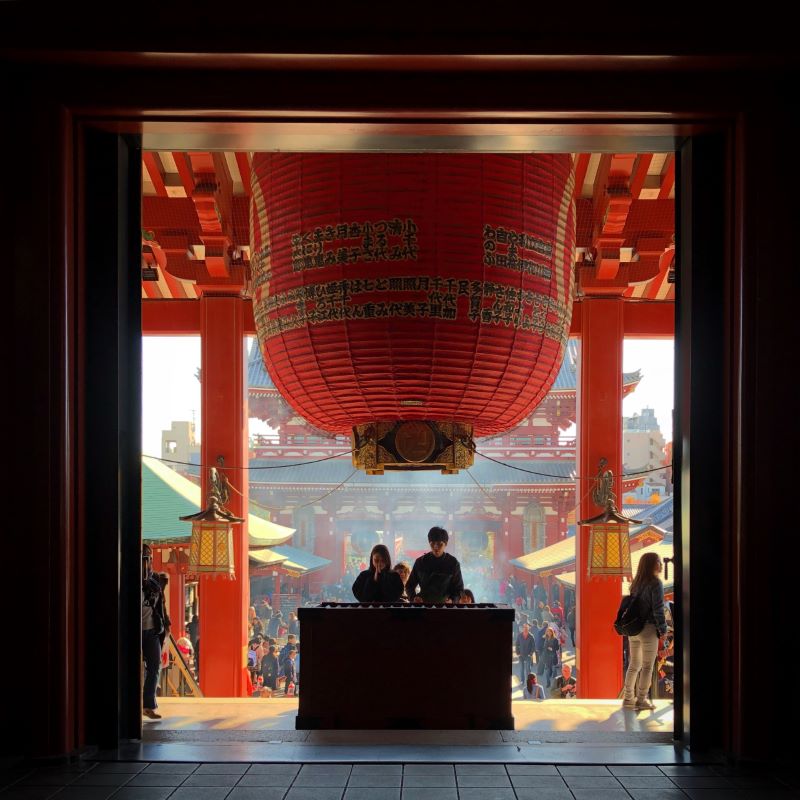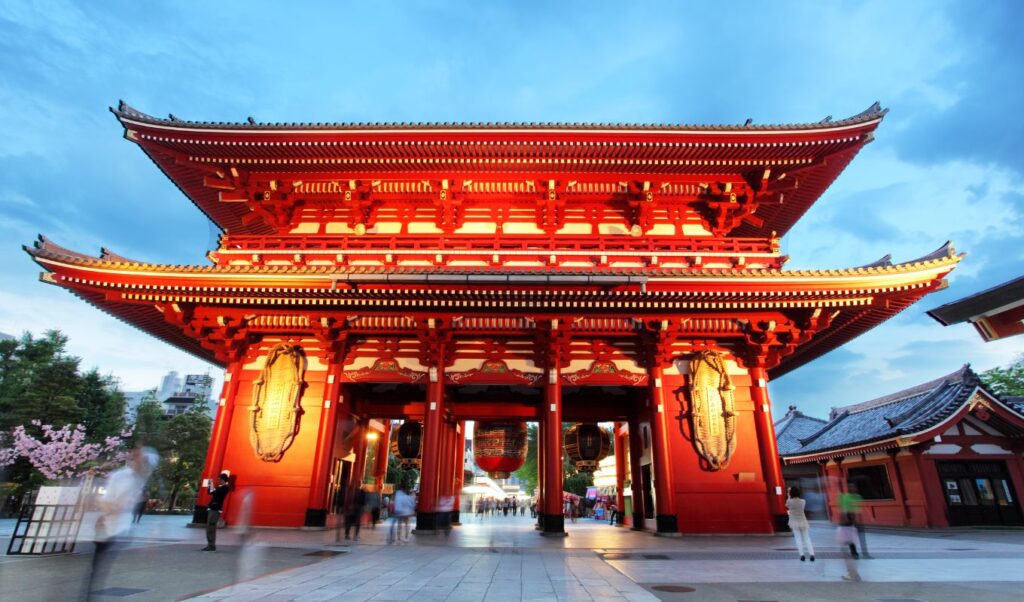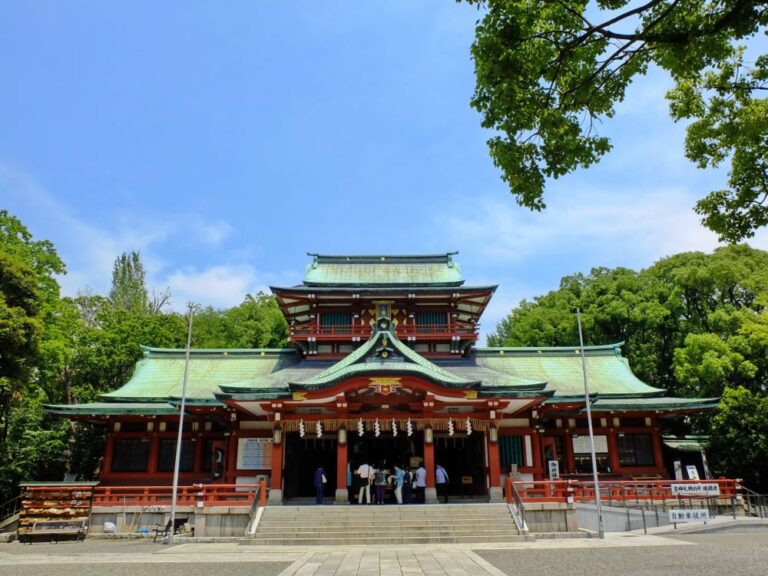Senso-ji Temple is the oldest temple in Tokyo, nicknamed “Asakusa Kannon” or “Kannon of Asakusa”. It is a famous sightseeing spot not only in Japan but also internationally.
In the Edo period , Tokugawa Ieyasu designated the area around Sensoji Temple as a place of prayer for the Tokugawa Shogunate, and the area flourished as the center of the downtown area.
Sensoji Temple is a Buddhist temple located in Asakusa, Tokyo, Japan. It is one of the oldest and most significant temples in the city, attracting millions of visitors every year. The temple is dedicated to the bodhisattva Kannon, also known as Guan Yin in Chinese, the goddess of mercy.
According to legend, in the year 628, two fishermen found a statue of Kannon in the nearby Sumida River, which they returned to the village headman. The headman recognized the statue’s importance and built a temple to enshrine it. The temple became a popular destination for pilgrims and travelers, and it has been rebuilt and expanded several times over the centuries.
Today, Sensoji Temple is a bustling complex of buildings and gardens, including the main hall, a five-story pagoda, a large gate called the Thunder Gate, and numerous shops and restaurants in the surrounding streets.
Visitors can participate in traditional Buddhist practices such as lighting incense and offering prayers, as well as enjoy the vibrant atmosphere of the area.
History
Sensoji Temple is a popular Buddhist temple located in Asakusa, Tokyo. The temple has a rich history that dates back to the 7th century. The following sub-sections detail the founding of Sensoji and its rebuilding and restoration over the years.
Founding of Sensoji
According to legend, in the year 628, two brothers fished a statue of Kannon, the goddess of mercy, out of the Sumida River. Despite returning the statue to the river, it kept returning to them. As a result, the brothers decided to enshrine the statue, and the Sensoji Temple was built for this purpose. The temple has since become one of the most significant Buddhist temples in Japan.
Rebuilding and Restoration
Throughout its history, Sensoji Temple has faced several challenges, including natural disasters and wars. The temple was destroyed several times, and each time it was rebuilt and restored to its former glory. One of the most significant restoration projects occurred in the 1950s, following the destruction of the temple during World War II.
Today, Sensoji Temple remains a popular tourist attraction, drawing millions of visitors annually. The temple’s rich history and cultural significance make it an essential part of Japan’s heritage.
Architecture
Kaminari-Mon (The Thunder Gate)
Kaminarimon is the most famous temple in Senso-ji Temple.
The Kaminarimon’s lantern is 3.4m in diameter, 4m high, and weighs 670kg, and the current Kaminarimon was rebuilt in 1960 due to a fire. Sensoji Temple was built in 628 and is said to be the oldest temple in Tokyo.
Sensoji Temple is a magnificent example of traditional Japanese architecture. The temple complex features several structures that showcase the beauty and intricacy of Japanese design.
Main Hall
The Main Hall, also known as the Hondo, is the centerpiece of the temple complex. The building is a two-story structure with a gabled roof and a large veranda. The exterior is adorned with intricate carvings and colorful paintings, while the interior is decorated with gold leaf and beautiful artwork. Visitors can enter the Main Hall and admire the central altar, which features a statue of Kannon, the Buddhist goddess of mercy.
Five-story Pagoda
The Five-story Pagoda is another iconic structure at Sensoji Temple. The pagoda stands at 53 meters tall and is one of the tallest pagodas in Japan. The pagoda is a symbol of the Buddhist cosmos and is said to represent the five elements: earth, water, fire, wind, and sky. Visitors can climb to the top of the pagoda and enjoy stunning views of the surrounding area.
Hozomon Gate
The Hozomon Gate is the main entrance to Sensoji Temple. The gate is a massive structure that features two large wooden statues of the gods Fujin and Raijin, who are said to protect the temple from evil spirits. The gate also features a large lantern that was donated by a wealthy merchant in the 17th century.
Overall, the architecture at Sensoji Temple is a testament to the skill and creativity of Japanese craftsmen. Visitors to the temple complex can marvel at the intricate designs, colorful paintings, and stunning sculptures that adorn the various structures.
Nearby Attractions
Sensoji Temple is a must-visit destination for anyone traveling to Tokyo. The temple grounds are filled with fascinating attractions that will keep visitors entertained for hours.
Asakusa Shrine
The Asakusa Shrine is a beautiful and historic shrine located on the temple grounds. This shrine is dedicated to the three men who founded the Sensoji Temple. Visitors can take a stroll through the shrine’s peaceful gardens and admire the intricate architecture of the shrine buildings.
Nakamise Shopping Street
After passing through the Kaminarimon, you will find Nakamise Street.
Nakamise Dori is lined with many shops selling everything from rice balls and doll pancakes to kimonos and wig shops.
Nakamise Shopping Street is a bustling street filled with souvenir shops, traditional Japanese snacks, and other unique items. Visitors can browse the shops and take home a piece of Japanese culture. The street is also home to many street performers who entertain visitors with their music and dance performances.
Hanayashiki Amusement Park
Hanayashiki Amusement Park is a small amusement park located near the Sensoji Temple. The park features a variety of rides and attractions, including a roller coaster, a Ferris wheel, and a haunted house. Visitors can enjoy a fun-filled day at the park and take a break from exploring the temple grounds.
Festivals
Sensoji Temple is a popular destination for locals and tourists alike, and it’s no surprise that the temple hosts several festivals throughout the year. These festivals are a great way to experience traditional Japanese culture and enjoy the lively atmosphere of the temple grounds. Here are a few of the most popular festivals:
Sanja Matsuri
Sanja Matsuri is one of the biggest festivals in Tokyo and takes place in May. It’s a three-day festival that celebrates the three founders of Sensoji Temple. During the festival, portable shrines known as mikoshi are carried through the streets by enthusiastic locals dressed in traditional clothing. The festival is known for its lively atmosphere and is a must-see for anyone visiting Tokyo in May.
Hozuki Market
Hozuki Market is held in July and is named after the hozuki plant, which is believed to have healing properties. The market is a great place to pick up souvenirs and local crafts, and there are plenty of food stalls selling traditional Japanese snacks. Visitors can also purchase hozuki plants and other traditional Japanese items.
Asakusa Samba Carnival
The Asakusa Samba Carnival is a colorful and lively event that takes place in August. It’s a parade that features samba dancers in colorful costumes, and it’s a great way to experience the lively atmosphere of Tokyo. The parade starts at Sensoji Temple and winds its way through the streets of Asakusa.



Details
| name | Sensoji Temple 浅草寺 |
|---|---|
| business hours | 6:30 – 17:00 (6:00 – from April to August) |
| business holiday | without a holiday |
| fee | free |
| residence | 2-3-1 Asakusa, Taito-ku, Tokyo |
| telephone number | 03-3842-0181 |
Access
Ginza Line,Toei Asakusa Line,Tobu Isesaki Line, about 1 minute walk from Asakusa Station.






